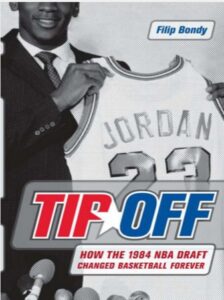Today’s blog article is once again about the history of the NBA. More specifically, one of the most famous and most discussed events in NBA history, the 1984 draft. This is often referred to as the best draft of all time and Filip Bondy took a look behind the scenes with “Tip Off: How the 1984 NBA Draft Changed Basketball Forever”. The subtitle is very fitting, as some of the players in the 1984 draft class did indeed change the future of their franchises and the NBA forever.

Tip off focuses on six players from the Draft
The book focuses on six sub-narratives, or six different players: the four future (from a 1984 perspective) superstars Hakeem Olajuwon (#1 pick), Michael Jordan (#3), Charles Barkley (#5) and John Stockton (#16). Also the fourth pick, Sam Perkins, who never became an All-Star, but can look back on a very good NBA career with well over 1000 games. And last but not least, the somewhat tragic figure of the draft, Sam Bowie, who will forever be known as the player the Portland Trail Blazers selected at #2 instead of Michael Jordan.
A big part of the book is the development of the six players before the draft, especially their time in college. For me personally, these stories were very interesting because as a non-American I don’t know much about college sports and mainly follow the NBA. In this book, however, I was able to learn a lot about the individual colleges in the 80s and coaches like Dean Smith or Bob Knight.
You then learn more about the players’ rookie seasons and how they settled in with their teams. In particular, Barkley’s problems with the 76ers’ renowned but ageing team are described. Stockton also came off the bench at first and the Rockets had the problem of getting Olajuwon and Ralph Sampson on the court together.
Bowie over Jordan
The author did a good job of describing the Blazers’ reasoning for selecting Bowie over Jordan. While this is a disastrous decision from today’s perspective, no one could have known at the time that Jordan would become the best player of all time. One exception is Charles Barkley, who claims to have been the only one who knew it back then. Bowie himself also has his say in the book. He makes a very satisfied impression and seems to be at peace with himself and the world. It should not be forgotten that Bowie also showed very good promise in the NBA, but was repeatedly set back by serious injuries. The author also rightly points out that the Blazers drafted Jerome Kersey with the 46th pick in the same draft, Clyde Drexler with pick 14 the year before and Terry Porter at 24 the year after. All of these are very good steals, but they are forgotten because of the Bowie/Jordan decision.
One criticism is that there are minor errors in the book in some places. For example, at the beginning of the book Charles Thomas is correctly referred to as the owner of the Houston Rockets, but just a few sentences later Ray Patterson (who was the general manager) is the owner. At another point, the book refers to the Virginia Cavaliers college team, who are shortly afterwards referred to as Cleveland (who are also called the Cavaliers). However, I am happy to forgive such minor errors if the content of the book is otherwise good, and that is the case here.
Overall, Filip Bondy’s Tip Off is a very good historical account of arguably the most famous draft of all time. You learn more about the six players and also some surprising things (Michael Jordan in tears after being criticized by coach Bob Knight at the 1984 Olympics). You also learn that several teams tried to trade for Michael Jordan. The Mavericks apparently offered their own pick plus Mark Aguirre, a very good offer at the time. Bulls fans will be glad that general manager Rod Thorn didn’t bite.
Get at AmazonThe button above is an affiliate link. If you order a book via this link, I will receive a small percentage of the purchase price as a commission. There are no additional costs for you.


